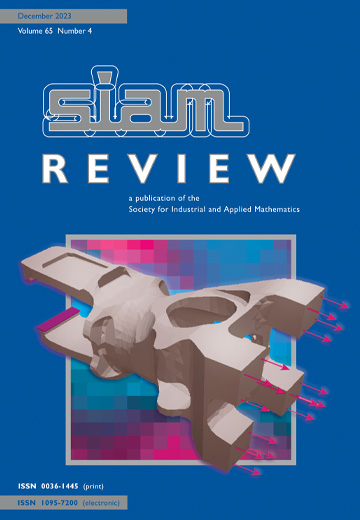费曼逆问题
IF 6.1
1区 数学
Q1 MATHEMATICS, APPLIED
引用次数: 0
摘要
SIAM Review》,第 66 卷第 4 期,第 694-718 页,2024 年 11 月。 我们分析了理查德-费曼(Richard Feynman)在英国广播公司纪录片《想象的乐趣》(Fun to Imagine)中提出的水波逆问题。我们表明,该问题可以建模为重力-毛细管波的反考希问题,对考希问题进行了详细分析,并给出了反问题的唯一性证明。出人意料的是,这对费曼的问题给出了肯定的答案。此外,我们还推导了连续和离散测量逆问题的稳定性估计,提出了一种简单的反演方法,并进行了数值实验来验证我们的结果。本文章由计算机程序翻译,如有差异,请以英文原文为准。
Feynman's Inverse Problem
SIAM Review, Volume 66, Issue 4, Page 694-718, November 2024.
We analyze an inverse problem for water waves posed by Richard Feynman in the BBC documentary Fun to Imagine. We show that the problem can be modeled as an inverse Cauchy problem for gravity-capillary waves, conduct a detailed analysis of the Cauchy problem, and give a uniqueness proof for the inverse problem. Somewhat surprisingly, this results in a positive answer to Feynman's question. In addition, we derive stability estimates for the inverse problem for both continuous and discrete measurements, propose a simple inversion method, and conduct numerical experiments to verify our results.
We analyze an inverse problem for water waves posed by Richard Feynman in the BBC documentary Fun to Imagine. We show that the problem can be modeled as an inverse Cauchy problem for gravity-capillary waves, conduct a detailed analysis of the Cauchy problem, and give a uniqueness proof for the inverse problem. Somewhat surprisingly, this results in a positive answer to Feynman's question. In addition, we derive stability estimates for the inverse problem for both continuous and discrete measurements, propose a simple inversion method, and conduct numerical experiments to verify our results.
求助全文
通过发布文献求助,成功后即可免费获取论文全文。
去求助
来源期刊

SIAM Review
数学-应用数学
CiteScore
16.90
自引率
0.00%
发文量
50
期刊介绍:
Survey and Review feature papers that provide an integrative and current viewpoint on important topics in applied or computational mathematics and scientific computing. These papers aim to offer a comprehensive perspective on the subject matter.
Research Spotlights publish concise research papers in applied and computational mathematics that are of interest to a wide range of readers in SIAM Review. The papers in this section present innovative ideas that are clearly explained and motivated. They stand out from regular publications in specific SIAM journals due to their accessibility and potential for widespread and long-lasting influence.
 求助内容:
求助内容: 应助结果提醒方式:
应助结果提醒方式:


